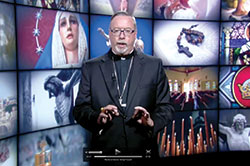Religious Education Supplement
Shelbyville parish helps with new USCCB program on prayer

Above is a scene from one of the “Prayer: The Faith Prayed” vignettes by Burlington, Vt., Bishop Christopher J. Coyne, former auxiliary bishop of the Archdiocese of Indianapolis. The vignettes are hosted on the website of the United States. Conference of Catholic Bishops (USCCB)
By Natalie Hoefer
“It happened that while Jesus was praying in a certain place, after he had finished, one of his disciples said to him, ‘Lord, teach us to pray …’ ” (Lk 11:1).
Some 2,000 years later, Christians are still seeking to learn how to pray.
The United States Conference of Catholic Bishops (USCCB) is launching an eight-session series to address this desire. The series is called “Prayer: The Faith Prayed.” Through expert-led webinars, videos and articles, Catholics—whether catechists, teachers, parents or simply interested individuals—now have easy access to online tools to grow in this imperative pillar of faith.
The USCCB did not create this series in isolation. Rather, they sought feedback from those in the know.
Members of St. Joseph Parish in Shelbyville were among those whose feedback helped make the series better by their input, says Michael Steier, associate director for the USCCB Secretariat for Evangelization and Catechesis.
“We need the connection between the parishes, the dioceses and the country,” he says of the request for parish feedback on the program. “[Pam McClure, St. Joseph administrator of youth religious education,] generously agreed to invite participation of adults—some catechists and some not catechists—who were interested in growing in their prayer life.
“They were very supportive and positive in their program review, and very often praised program features that they found helpful and that they encouraged us not to lose after the pilot was over.”
The program, which is online and will be available in English and Spanish, is based on the fourth pillar of the Catechism of the Catholic Church and chapters 35-36 of the United States Catholic Catechism for Adults.
“The series is of great use for catechetical leaders in parishes or teachers in Catholic schools, or parents providing home school education, and people who want to grow in their prayer life,” Steier explains. “One person said she was pleasantly surprised that this course will assist people who want to grow in faith but don’t have a specific mission to accomplish.”
The program offers history, information, applications and examples of prayer highlighted in eight sessions: What Is Prayer? Seeds and Flowering; Forms of Prayer; Teaching Prayer to Persons with Disabilities; Sources and Manner of Praying; Prayer in Communion with Mary; Prayer and Penance; Praying the Lord’s Prayer; and Leading Others in Prayer.
Each session offers tools in a variety of media—webinars (the primary source for learning), video vignettes, articles, PowerPoint presentations and other tools.
Burlington, Vt., Bishop Christopher J. Coyne, former auxiliary bishop of the Archdiocese of Indianapolis, created a series of short video vignettes of about three minutes each focusing on gestures used during Mass.
“I recommend people look at Bishop Coyne’s vignettes, even if they don’t do the whole series,” says Steier. “They are a great way to get a lot out of a little bit of time.”
The vignettes can be viewed by visiting goo.gl/0QqaT1.
Beth Schoentrup, a former leader of adult religious education at St. Joseph, says that she “enjoyed the sessions a lot.”
“The piece on prayer and various forms of prayer, I thought that was very strong and would help adult catechists,” she says.
“Really, many of the speakers were strong. I liked the way some of the speakers looked at things from a different angle, but still a Catholic angle.”
Some of the other comments Steier received from the St. Joseph reviewers helped him know what the series got right:
-
“Liked working through the program at my own pace. Some [programs] you have to take wherever it’s offered and the pace is dictated by the leader and number of participants. With this, I could choose whatever time and date to participate.”
-
“Loved Father DeSiano linking scriptural characters to religious orders.”
-
“I liked the exercises and the meditation on the body in motion that Bishop Coyne did.”
-
“The series built one session upon the other. That was very helpful.”
-
“I liked the illustrations in the PowerPoint presentations.”
-
“I benefited from the good historical background and scriptural background that helped demonstrate prayer forms, especially the Psalms.”
-
“I felt encouraged to slow down, savor and try new ways of prayer.”
-
“The presenters encouraged real and true intimacy with God. This reminds me we have to listen when we pray, not just ramble and give one-sided statements.”
One piece of feedback Steier received from the St. Joseph reviewers led to a positive addition to the series: the creation of vocabulary sheets.
“It was suggested that some terms were used that some [people] might not be familiar with,” he says. “So we looked at key words causing issues or that could cause issues, and went to the glossary of the catechism for comments on those words.”
The program is almost complete, with Steier estimating it being finished sometime between late October and Christmas.
What has already been developed can be viewed by logging onto www.usccb.org/leadership, then selecting “Prayer: The Faith Prayed” from the list on the right hand side of the screen.
Archdiocesan director of catechesis Ken Ogorek is excited about the program.
“The evangelism and catechesis secretariat of the USCCB has been putting out some really good resources,” he says. “Anything they do is top quality. They’ve really made it a point to invite some very talented people to share their gifts.
“I really encourage people to capitalize on any of their resources.” †
